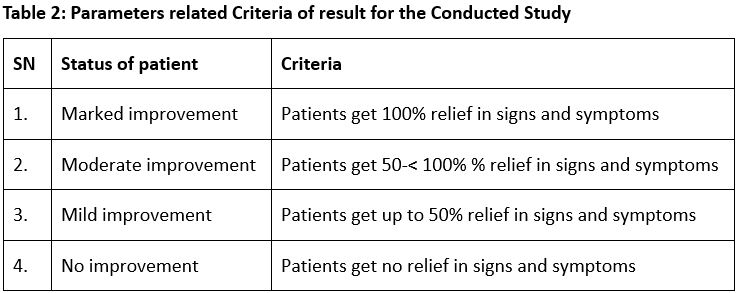Effect of Kanashatahwadi Kashaya Orally and Asanadi Niruha Basti in management of Polycystic Ovarian Disease (PCOD)
DOI:
https://doi.org/10.21760/jaims.10.6.6Keywords:
Asanadi Niruha Basti, Kanashatahwadi Kashaya, Basti, Niruha Basti, Yoga Basti, Polycystic Ovarian DiseaseAbstract
Polycystic ovarian syndrome is a heterogeneous, multisystem endocrinopathy in women of reproductive age with the ovarian expression of various metabolic disturbances and a wide spectrum of clinical features such as obesity, menstrual abnormalities, and Hyperandrogenism. This disease was described by and named as Stein-Leventhal syndrome in 1935. This condition is fairly common affecting 5%-15% of adolescent girls.[1] Materials and Methods: In this study, (n=45) eligible patients were selected randomly for this study on the basis of inclusion and exclusion criteria. All selected patients were treated with Kanashatahwdi Kashaya/decoction orally for 3 months along with one cycle of Yoga Basti. Asanadi Niruha Basti and Murchhita Tila-Taila Matra Basti). Result: After the treatment, some patients experienced only symptomatic improvements. Out of a total maximum patients had only mild improvement in symptoms, out of (n=45) only 4 Patients had no improvement, (n=4) had moderate improvement, and another (n=4) had marked improvement. Conclusion: Application of Basti therapy i.e., Asanadi Niruha Basti with oral administration of Kanashatahwadi Kashaya had a beneficial effect on Polycystic ovarian syndrome.
Downloads
References
Howkins & Bourne. Shaw's Textbook of Gynecology. 16th ed. New Delhi: Reed Elsevier India Pvt Ltd; 2015. p.314–318. eBook ISBN: 978-81-312-3872-1.
Deans R. Polycystic ovary syndrome in adolescence. Med Sci. 2019;7:101. doi:10.3390/medsci7100101.
Witchel SF, Oberfield SE, Peña AS. Polycystic ovary syndrome: pathophysiology, presentation, and treatment with emphasis on adolescent girls. J Endocr Soc. 2019;3:1545–73. doi:10.1210/js.2019-00078.
Office on Women’s Health. Polycystic Ovary Syndrome [Internet]. [Accessed 2021 Sep 22]. Available from: https://www.womenshealth.gov/a-z-topics/polycystic-ovary-syndrome
Carmina E, Dewallly D, Diamanti-Kandarakis E, Escobar-Morreale HF, Futterweit W. The Androgen Excess and PCOS Society criteria for polycystic ovarian syndrome: the complete task force report. Fertil Steril. 2009;91:456–88.
Zaveri M, Khandhar A, Patel S, Patel A. Chemistry and pharmacology of Piper longum L. Int J Pharm Sci Rev Res. 2010;5(1):Article-010.
Pereira DJ, Tharannum S. Pharmacological potential of volatile oil and extract of Anethum sowa L.: a review. Res J Agric Sci. 2021;13(2). ISSN: 0976-1675.
Shende A, Joshi S, Koli PG. Evaluation of effects of Caesalpinia crista on letrozole-induced models of PCOS. Cureus. 2023;15:e34215. doi:10.7759/cureus.34215. PMID: 36843780; PMCID: PMC9957572.
Ionescu OM, Frincu F, Mehedintu A, et al. Berberine—a promising therapeutic approach to PCOS in infertile/pregnant women. Life (Basel). 2023 Jan 2;13(1):125. doi:10.3390/life13010125. PMID: 36676074; PMCID: PMC9864590.
Wu WH, Kang YP, Wang NH, Jou HJ, Wang TA. Sesame ingestion affects sex hormones, antioxidant status, and blood lipids in postmenopausal women. J Nutr. 2006;136(5):1270–5. doi:10.1093/jn/136.5.1270. PMID: 16614415.
Jafari F, Khalilzadeh S, Nejatbakhsh F, Maziar M. Therapeutic effects of garlic (Allium sativum) on female reproductive system: a systematic review. Heliyon. 2023;9:e22555. doi:10.1016/j.heliyon.2023.e22555. PMID: 38076037; PMCID: PMC10709373.
Raj DR, Merlin NJ, Dharan SS. Hinguvachadi Choornam—an in silico approach to confirm therapeutic efficacy towards PCOS. Res J Pharm Technol. 2021;14(1):231–4. doi:10.5958/0974-360X.2021.00040.8.
Hugar AL, Kanjikar AP, Londonkar RL. Reproductive effects of Pterocarpus marsupium methanolic extract on testosterone propionate-induced PCOS in female rats. Recent Pat Endocr Metab Immune Drug Discov. 2017;11:39–43. doi:10.2174/1871530317666170912153934. PMID: 28901866.
Zhang J, Arshad K, Siddique R, et al. Rubia cordifolia pharmacological potential against letrozole-induced PCOS in rats: In vitro, in vivo and mechanistic approach. Heliyon. 2024;10(2):e34298. doi:10.1016/j.heliyon.2024.e34298.
Sharma M, Ashiya, Dei LP. Ayurvedic management of hyperprolactinemia associated with PCOS: a case report. Int J Ayurvedic Pharm Chem. 2021;14(1). Available from: www.ijapc.com
Saiyed A, Jahan N, Makbul SAA, et al. Effect of combination of Withania somnifera and Tribulus terrestris on letrozole-induced PCOS in rats. Integr Med Res. 2016;5(4):293–300. doi:10.1016/j.imr.2016.10.002.
Siriwardene SAD, Karunathilaka LPA, Kodituwakku ND, Karunarathne YAUD. Clinical efficacy of Ayurveda treatment regimen on subfertility with PCOS. Ayu. 2010;31(1):24–7. doi:10.4103/0974-8520.68203. PMID: 22131680; PMCID: PMC3215317.
Gupte PA, Khade KN, Wagh GN, et al. Effect of combination of Curcuma longa with Emblica officinalis in PCOS: exploratory clinical study. J Diabetol. 2023;14(3):126–34. doi:10.4103/jod.jod_17_23.
Dawane JS, Pandit V, Khade KS, et al. Efficacy of herbal formulation Nisamalaki in animal model of PCOS. Ancient Sci Life. 2017;37:86–93.















